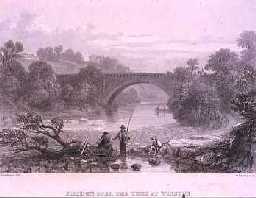Local History
Winston (County Durham)
Winston is an attractive village on the rocky banks of the River Tees. A stone bridge built in 1764 to replace a medieval one built sometime before 1424, crosses the river. When it was built it was the longest bridge of its kind.
It is possible that there has been a bridge here since the Roman period. An aerial photograph of this area shows the cropmarks of a small enclosure. It is possible that this was a small Roman fort defending the river crossing. The nearby church also contains stones which may be have been worked in the Roman period. It is possible that these were reused from an earlier Roman bridge.
The church, although containing mainly later work, may have been originally built in the Anglo-Saxon period. The fragments of a stone cross of this date was found in the churchyard, and is now on show at the west end of the church. The main church was built in the 13th century, though the turrets, aisles, porch and part of the nave were of later date. The church was restored in 1848. This was not the only religious site in medieval Winston. Until the 19th century a chapel or hermitage stood in Heighley. It may have been a chapel for the nearby manor house of Heighley, which stood to the southwest of Winston, on the sloping ground between the road and the Tees. It was probably built in the 15th century.
The parish church of St. Andrew's is known to contain two war memorial plaques, one dedicated to each of the World Wars. The First World War plaque commemorates 8 fallen men of the parish whilst 7 names are found on the plaque dedicated to WW2.
It is possible that there has been a bridge here since the Roman period. An aerial photograph of this area shows the cropmarks of a small enclosure. It is possible that this was a small Roman fort defending the river crossing. The nearby church also contains stones which may be have been worked in the Roman period. It is possible that these were reused from an earlier Roman bridge.
The church, although containing mainly later work, may have been originally built in the Anglo-Saxon period. The fragments of a stone cross of this date was found in the churchyard, and is now on show at the west end of the church. The main church was built in the 13th century, though the turrets, aisles, porch and part of the nave were of later date. The church was restored in 1848. This was not the only religious site in medieval Winston. Until the 19th century a chapel or hermitage stood in Heighley. It may have been a chapel for the nearby manor house of Heighley, which stood to the southwest of Winston, on the sloping ground between the road and the Tees. It was probably built in the 15th century.
The parish church of St. Andrew's is known to contain two war memorial plaques, one dedicated to each of the World Wars. The First World War plaque commemorates 8 fallen men of the parish whilst 7 names are found on the plaque dedicated to WW2.
D6907
Heart of Teesdale Project Heritage Audit; North of England Civic Trust
Disclaimer -
Please note that this information has been compiled from a number of different sources. Durham County Council and Northumberland County Council can accept no responsibility for any inaccuracy contained therein. If you wish to use/copy any of the images, please ensure that you read the Copyright information provided.
